Captain Daggett - remembered
- Home
- Latest News
- 2024
- March 2024
- Captain Daggett - remembered
A period of 107 years separated the last time members of various families had trodden these fields, but on 19 March 2024, relatives of men who served in the 4/Tyneside Scottish came together for the first time at Rue-Petillon British Cemetery and were able to stand over their ancestors’ graves and pay their respects.
The occasion was the rededication ceremony for the Officer Commanding ‘A’ Company. He was a young Captain and pre-war solicitor called Cedric Daggett. 107 years ago he was last seen on the lip of a German trench during what turned into a costly raid.
As a report on the raid details
"2/Lt Milloy... together with Pte Dillon dropped into the enemy trench again and proceeded to the right...He [Milloy] again returned to Captain Daggett and noticed two of the enemy standing on top of the parapet firing Very lights. Shortly after this three of our men were seen leaving the enemy front line being pursued by a strong party of Germans.... Captain Daggett and 2/Lt Milloy then rushed to the wire and commenced to clear their wounded men. This work was proceeded with until the enemy bombs began to drop on this party. Captain Daggett, taking in the situation, ordered everybody to jump clear of the wire and said 'everyone for himself'. On 2/Lt Milloy turning round, he discovered Captain Daggett and Pte Dillon nowhere near him...." [1]
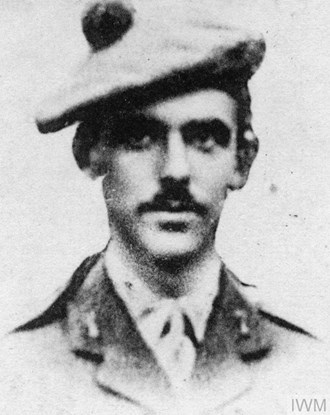
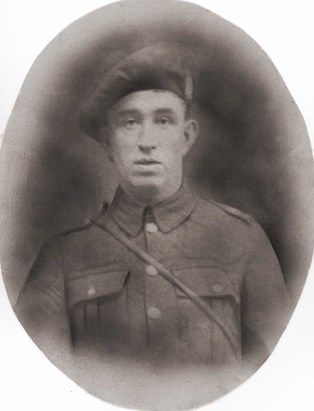
Above: Captain Cedric Daggett (Courtesy IWM) and Pte Richard Dillon.
Below: A group of the raiders taken in the days leading up the attack (Courtesy: Edward Chapman). Cedric is seated with other offices. He is in the centre of the row, with an MC ribbon is visible.
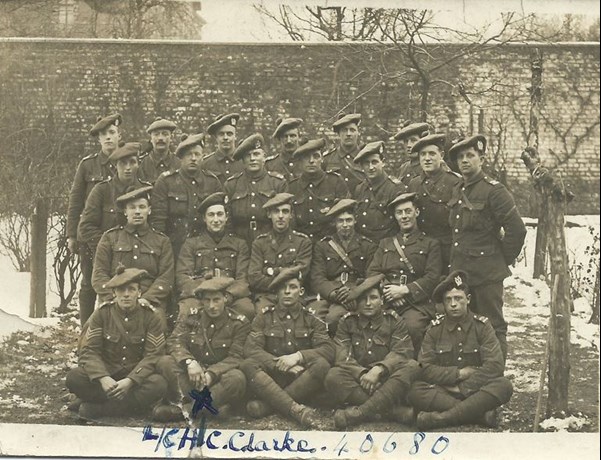
That was 11 February 1917. Cedric Daggett and a number of his men were killed in the German trench and – having no identification on them – were buried by the Germans some miles behind the German lines, near Lille.
Other men taking part in the raid were killed and were recovered by the British. Their bodies were recognised and they were buried a few miles behind British lines.
Back in the 1920s the Imperial (as it was then) War Graves Commission re-interred the dozen men (who had originally been buried by the Germans) at Rue-Petillon. These re- burials were possibly hasty, as the graves did not exactly replicate the original burials undertaken by the Germans. Virtually all were totally unidentified apart from their date of death – 11 February 1917 – but one was buried as an ‘unknown officer’, no doubt partly identified from the cut of his uniform.
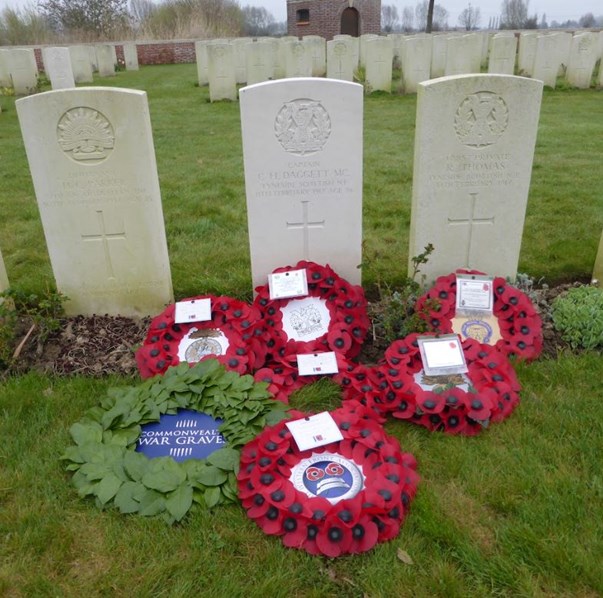
Above: The new headstone of Captain Daggett, MC with wreaths from those attending.
Full details of the research that led to the identification can be found in the article ‘Lost Raiders Found’. This explains how the research led to the conclusion that Captain Daggett was the ‘unknown officer’ buried with his comrades.
In late 2023, the JCCC advised me that the ceremony would be taking place to rededicate Cedric Daggett’s grave. It seemed too good an opportunity to miss to attempt the challenge of trying to locate the families of all those killed on the raid. With enthusiasm and masses of patience, and after literally hundreds of hours of work, Jill Stewart, the WFA’s Honorary Secretary managed to track down several of the families of the men from the battalion. Those that were identified were invited to attend the ceremony (although unfortunately a number were unable to attend) and so it was on Tuesday 19 March, in unseasonably warm weather, the gathering took place.
The group included Cedric Daggett’s distant cousin, Liz Ashforth and her son Crispin. Also present was Edward Chapman, who was related to Private Henry Clarke.
Ruth Abel and her husband were also there to remember David Walling. All these soldiers were almost certainly buried in the graves marked ‘unknown soldier 11 February 1917’.
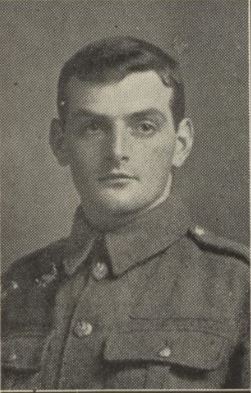
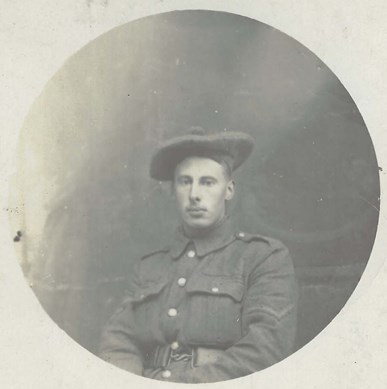
Above: Pte David Walling (left) and Pte Henry Clarke (right).
A further group was there to remember Private John (or – as he was apparently known ‘Jack’) Sale. It was fitting that Sam Ellsmore and her family was present as they were able to ‘represent’ those soldiers who were buried by the British. These men – also killed on 11 February – are now buried at Cite Bonjean in nearby Armentieres.
With a few minutes to go before the ceremony the various families gathered to say ‘hello’ and gather round the row of headstones. Apart from Liz and Crispin, who were there to remember Cedric Daggett, it was obviously impossible to know which graves ‘belonged’ to which of the other men. But it was fitting – and helped to complete a circle that was 107 years old – that the families were there.
The ceremony opened with Reverend Thomas Sander CF, Chaplain to The Household Cavalry calling the assembled to pray, quoting from Corinthians. Others represented in the service that followed were from the British Embassy, the regiment (Captain Jordan Whiteman Regimental Adjutant, The Royal Regiment of Fusiliers) and Regimental Associations (Northumberland Fusiliers and Tyneside Scottish). Also officially represented were the CWGC and The Western Front Association.
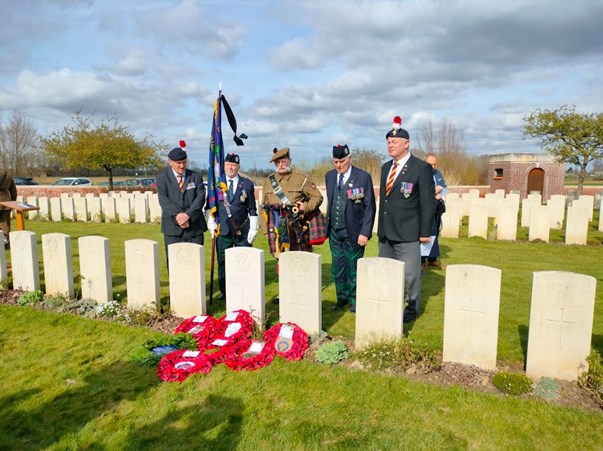
Above: The piper and Regimental Associations
JCCC Caseworker, Rosie Barron, later said: “It has been a privilege to have organised this rededication service today and to have played a part in the identification of Capt Daggett’s grave. He was clearly a very popular, capable and brave young Officer, who lost his life whilst assisting his wounded men. It is important that the memory of men such as Capt Daggett is kept alive, and his sacrifice is not forgotten.”
Towards the end of the ceremony, the last post was played. Fittingly – and emotionally – the service ended with a piper playing ‘Highland Laddie’ which was the regimental march of the Tyneside Scottish. It would have been recognized by Cedric Daggett and the other men. The piper slowly made his way to the exit of the ceremony with the notes of the march receding into the distance.
After the ceremony, Captain Whiteman formally handed to Liz a folded Union Flag to thank her for her ancestor’s service.
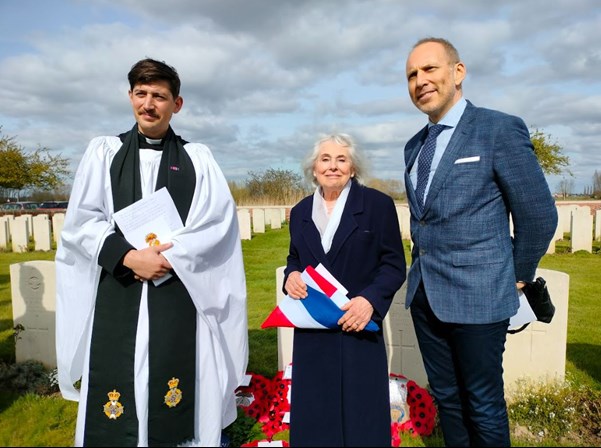
Above: Liz Ashoforth and her son Crispin with Reverend Thomas Sander CF
Further photographs were taken and the parties were invited to reconvene at a Great War themed café (Mademoiselle from Armentieres) in the town of Armentieres. But a quick deviation was agreed and a convoy of four cars headed to the field where the Trench Raid took place. Although there are obviously no features left, it was possible to take the families to the spot the raid started from and show where the German trenches had been, and where Cedric Daggett had last been seen.
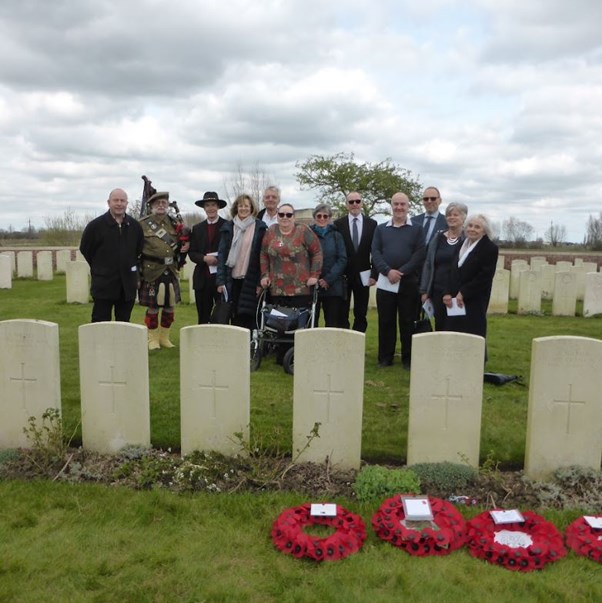
Above: The families of the soldiers were able to gather round the 'unknown headstones' for the first time in 107 years
Tea and cakes were then gratefully consumed at the café which was most convivial.
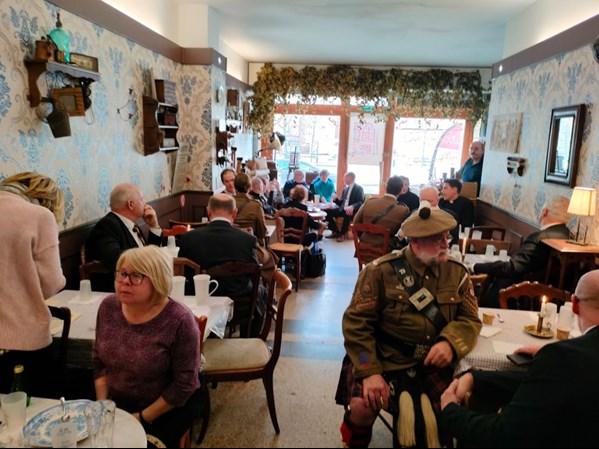
Above: After the ceremony, refreshments were served for the families and all who attended the ceremony.
After the refreshments a smaller group, including the family of Jack Sale headed to Cite Bonjean and the graves of the other men to be killed in the Trench Raid were identified. This was a poignant moment for Sam and the other family members. They had been trying to locate Jack’s grave for several years but had been misled by a mistaken ‘family tradition’ which – together with the confusion about Jack or John had prevented them from ever finding his last resting place. So – at last – another family was able to ‘complete the circle’ and stand by their ancestor’s last resting place.
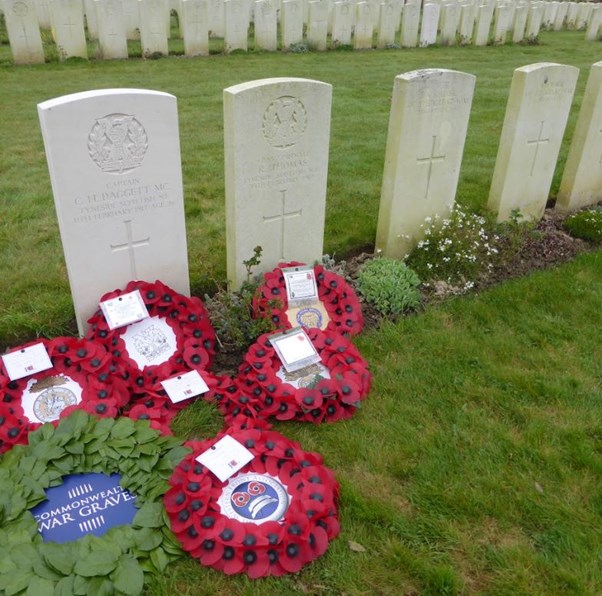
David Tattersfield
Vice-Chairman, The Western Front Association
[1] Pvt Richard Dillon was among those killed. He is buried at Cite Bonjean. 2/Lt Stewart Milloy survived the war. Extract from the 23rd Northumberland Fusiliers war diary (TNA WO95/2459)





